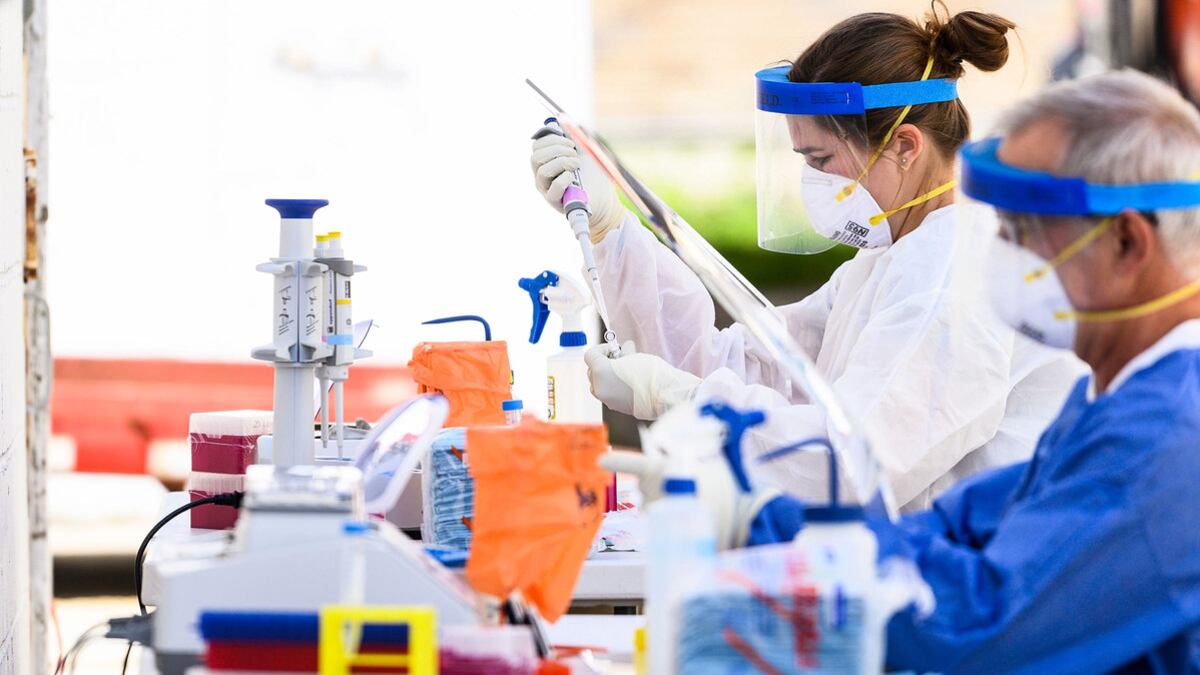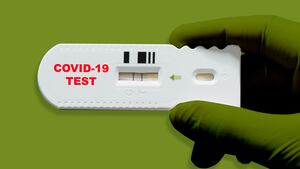Over seven months after the novel coronavirus went global, the United States still isn’t testing enough people. Nor is the U.S. delivering results quickly enough to provide meaningful disease surveillance.
But virologists Dave O’Connor and Chris Mason had a simple idea for loosening up the testing logjam: pack vans with $5,000 worth of testing equipment and drive them around key locations in badly-hit communities with low testing rates and lagging test turnaround times.
Welcome to Rabbit Hole, where we dive deep on the biggest story. It’s for Beast Inside members only. Join up today.
O’Connor and Mason are each running their own van-lab in Wisconsin on an experimental basis. The mobile testing operations have backing from the National Institutes of Health, but that doesn’t mean they’re definitive. The tests are, to use the technical term, “non-diagnostic,” meaning you’d still need to see your doctor to be sure whether or not you’re infected.
But the testing vans are fast and easy on patients. They can give you a heads-up that you’re potentially infected, which hopefully would persuade you to change your behavior and spare your friends and neighbors. And at a cost of $5,000—plus the van and staff—all but the smallest communities could theoretically afford their own mobile lab.
The need is clear. U.S. authorities have registered over 4.9 million COVID-19 infections since January. That number grows by thousands daily. But the confirmed infections are the tip of the iceberg. “Eighty or 95 percent of people who are infected don’t get tested,” O’Connor told The Daily Beast. (The CDC has previously suggested the actual case count is 10 times as high as the official record.)
There are several reasons for paltry test rates. Many people infected with SARS-CoV-2 never know they have it—they’re asymptomatic. Since they never get sick, they never bother getting a test.
Other people do get sick but simply ride out the disease at home—or die without ever being hospitalized. Still others would like to get tested but decide a test is too expensive, inconvenient, or scary. It doesn’t help that the most widespread form of testing involves sticking a swab deep into your nasal passage.
And a low rate of testing isn’t the only problem. To convince people to seek treatment or at least self-quarantine before they infect a lot of other people, a test needs to come back fast. It does little good if you take a test on Sunday, then go to work Monday through Friday, before getting your positive test result back on Saturday. By then, it’s likely too late.
But that’s exactly what’s happening in states like North Carolina, where testing turnaround times have stretched out to six or seven days owing to a spike in demand and a shortage of lab equipment. Residents in Arizona, another COVID-19 hot spot, have cited weeks-long delays in reporting.
O’Connor and Mason, respectively from the University of Wisconsin and the Weill Cornell Medical College in New York, are hoping their fast mobile testing set-ups can help increase testing rates and decrease the wait for results. O’Connor’s squad has been in Madison since mid-July, running trials with their van. Mason and his team got started in Racine around the same time after spending a couple months conducting tests in New York City.
Together, they’ve tested around 1,100 people, they said. And fast. Turnaround is usually just a couple hours, O’Connor claimed. Both teams are using a testing method called “reverse transcription loop-mediated isothermal amplification,” or RT-LAMP. The method amplifies RNA in order to detect pathogens.
A test subject spits into a vial—no invasive swab. The testers heat the sample to inactivate any pathogens that might be present, toss the sample in a centrifuge, add special reagents, then look for a telltale shift in the sample from pink to yellow, indicating the presence of the novel coronavirus. O’Connor and Mason separately told The Daily Beast that there are no shortages of any of the materials they use in their mobile labs, though reagents and other supplies have been an issue nationwide since the pandemic began.
The tech is straightforward. But it’s also “not as sensitive as diagnostic [molecular] tests in laboratory testing,” O’Connor and co-authors wrote in a short summary of the van tests that appeared online on Wednesday. The summary has not yet been peer-reviewed.
O’Connor’s team tested 494 people and got three positive results. Follow-up molecular testing at a bricks-and-mortar lab confirmed two of the positive hits, meaning one was probably a false-positive.
The lack of sensitivity compared to slower molecular testing doesn’t mean an RT-LAMP test isn’t useful. “Its detection threshold is sufficient to identify most individuals who have viral loads consistent with live virus shedding who likely pose the greatest risk of transmission,” O’Connor and his co-authors wrote.
The idea is for the vans to function as the diagnostic equivalents of military early-warning radars, which can quickly spot distant threats and give defenders the time they need to respond. As with a radar, authorities would want to reinforce their testing vans with other detection methods.
A mobile lab “is a key part of a three-prong plan that includes centralized labs, point-of-care testing, and at-home testing,” Mason said. “All are going to be needed, I think.”
Also like a radar, you’d want to deploy your van in a strategic location. Mason, for his part, took his van to Racine to test city workers whose jobs are essential. O’Connor is targeting schools and communities adjacent to schools. “People who are contagious are the greatest risk to schools reopening,” he explained.
Experts are cautiously optimistic that O’Connor and Mason’s system will help. “As a way to get out there and catch cases... I think that’s a good thing,” Susan Butler-Wu, a clinical microbiologist at the University of Southern California, told The Daily Beast.
Jeffrey Klausner, a professor of medicine and public health at UCLA who previously worked at the Centers for Disease Control, told The Daily Beast he also approved. “We definitely need more rapid and easy to use tests for COVID-19 detection.”
But Butler-Wu warned against placing too much faith in testing—whether this less sensitive version, or in general.
“We can’t test our way to normalcy,” he said.
Widespread and fast testing doesn’t actually stop the disease. It just tells us where it is and how it’s spreading. Until a vaccine is available, only social distancing, masks, hand-washing, and other public-health measures can slow the novel-coronavirus.
“We can’t just test and carry on,” Butler-Wu said.





